As foreigners created a living space in Shanghai from the 19th century, they introduced various services to support life in the new city. I mentioned schools with the College Municipal Francais and postal services in previous posts. Hospital was another of the public services that were created.
The first foreign hospital in Shanghai was the Shanghai General hospital opened in 1864 on the Quai de France, or French Bund, at the corner of Rue Colbert (See post “Rue Colbert” for more on this street). This building was a few steps away from the new French Consulate building also located on the Quai de France (See post “Former French Consulate” ). The hospital was staffed with nurses from Les filles de la Charite de Saint Vincent de Paul, a French Catholics order.
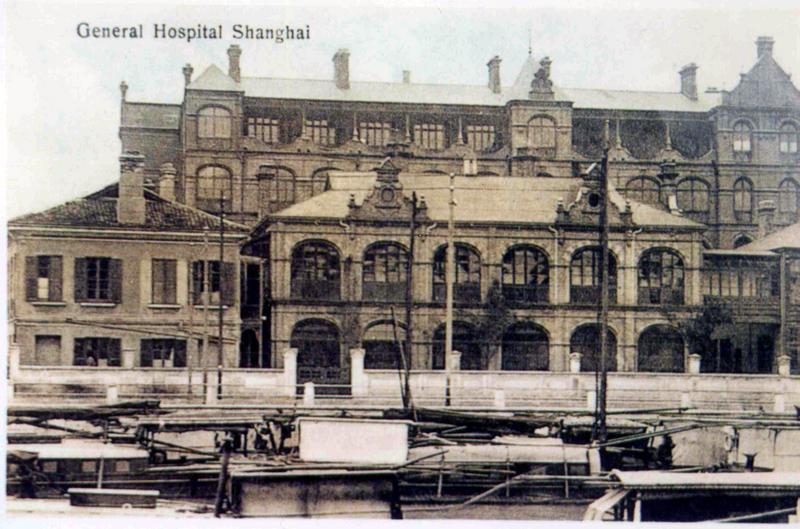
According to “Histoire de la concession Française” by Maybon & Fredet, the ground rental was stopped in 1875, and the hospital had to move. It was then decided to build a new one. The hospital needed a large area for a reasonable price and ground price in central Shanghai was already very high. After much debate, a plot was chosen on the North side of the Suzhou River in the International Settlement. “At that time, it was nearly still the countryside. Few people lived there as it was away from the Shanghai city itself.” Like for the General Post Office next from the new location, the choice was difficult and it took a long time to decide as the move would add 10 to 20 minutes of transportation in case of emergency. It is very amusing to notice that the same area is now considered very central and desirable.
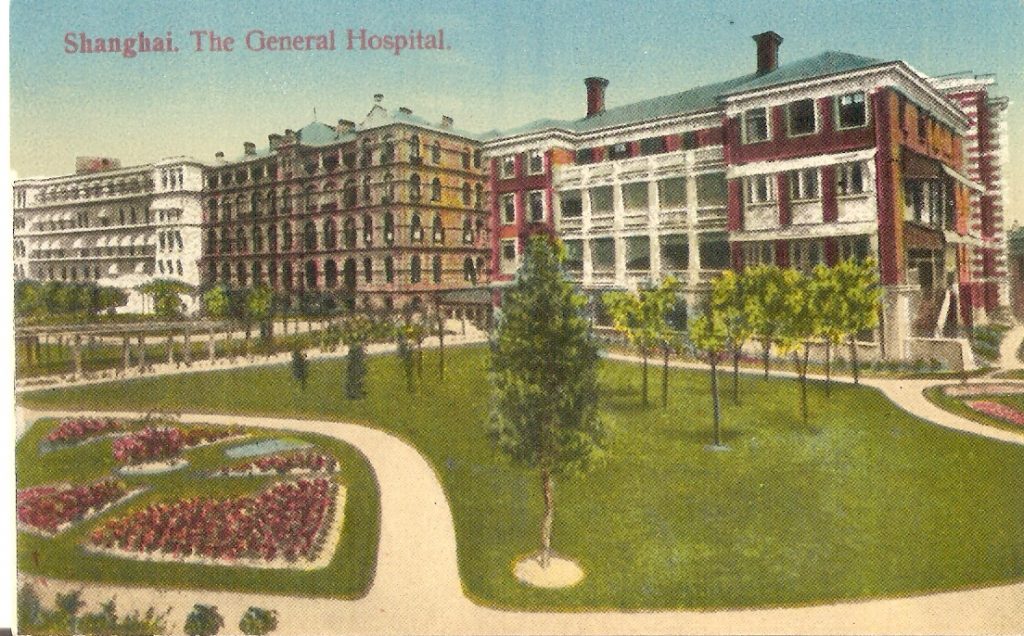
The hospital building was of Colonial British Style, that as now mostly disappeared in Shanghai. As the city developed more capacity and space was needed and more buildings were added on the same plot, a red brick building on the right and a neoclassical building on the left. The left one is probably from the 1910s as it looks similar to other buildings from this time. The right one is probably from the late 1920s or early 1930s looking at its architecture. Above picture shows that the garden on the Suzhou creek side was already well maintained, long before the recent recreation of the Suzhou Creek promenade.
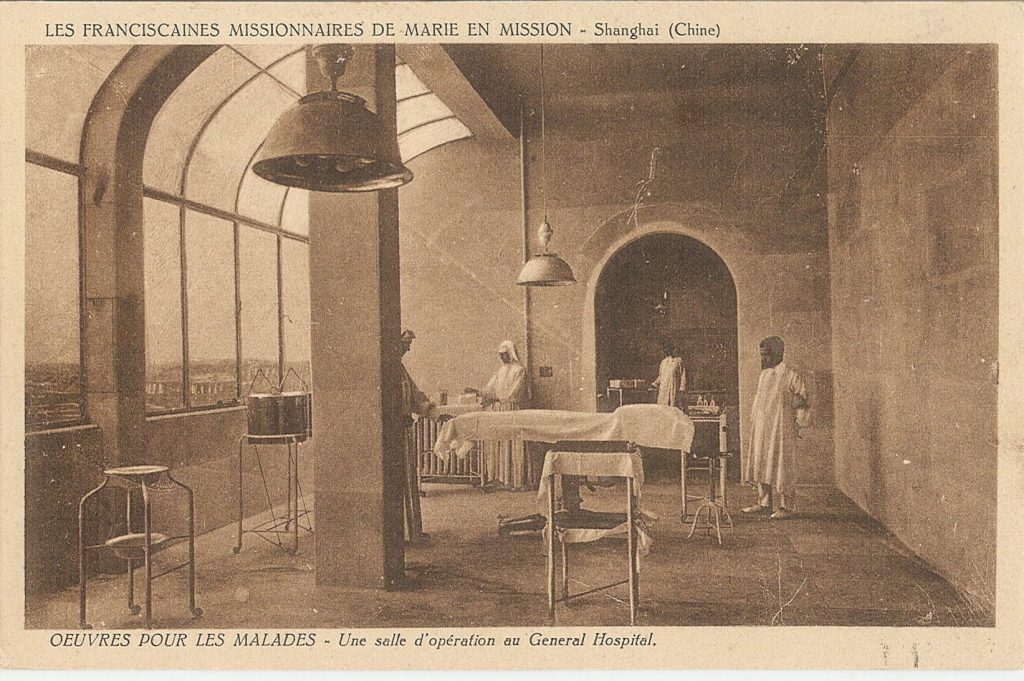
In the 1930’s the nurses were replaces by another Catholics order, the “Institut des soeurs Franciscaines”. The picture right shows an operation theater staffed with nurses from this order. The Shanghai General Hospital was still one of the main hospital in the International Settlement, along with “Hopital Sainte Marie” (today’s Ruijin Hospital), the German hospital (today’s HuaShan hospital), Lester Hospital on Shandong lu and Shanghai Country hospital (today Huadong hospital).
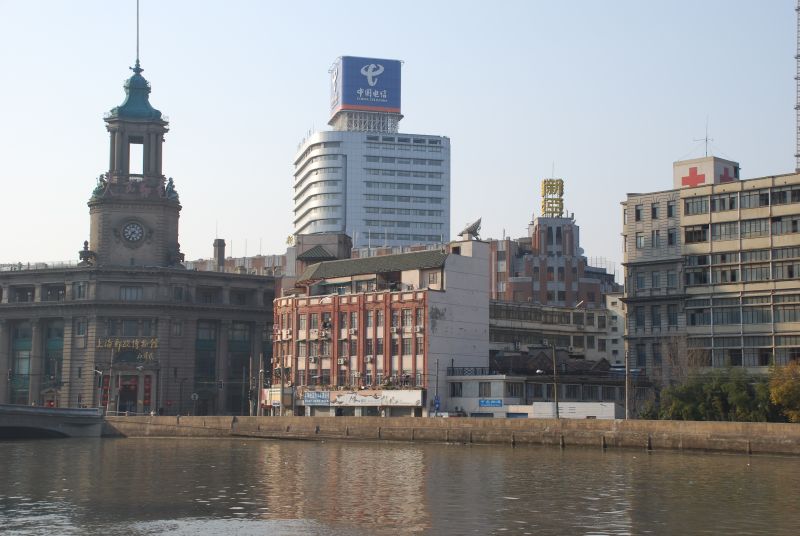
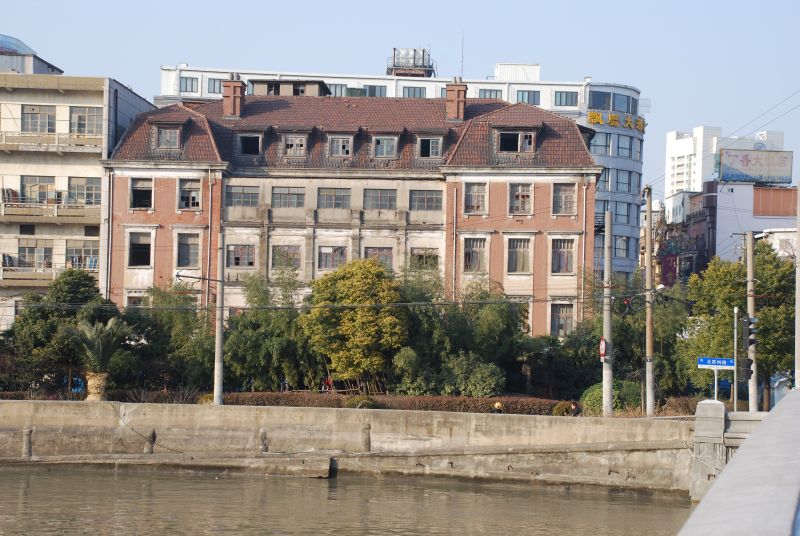
As for many historical buildings in Shanghai there was little maintenance over time. The original middle building was replaced by a concrete cube probably in the 1970s. Both side buildings got added floors and transformation to gain space. The left building can be seen on the righ side of left picture. It suffered the most. The right building was kept in better outside shape. Both did not escape destruction in April 2010, just before the Shanghai Expo opening. Only a small red brick building on the right has been kept, being the last remaining part of the former Shanghai General hospital. It was the former morgue of the hospital.
August 2018: A new building has been built on this location and just opened as the Bellagio hotel. The fake Art Deco style is supposed to match the location’s history but has none of the grandeur of the original. The remaining building has been renovated and is mentionned as the former Shanghai General Hospital.
My sister Rebecca Willens was born at the Hopital Sainte Marie (present day Ruijin Hospital) attended by the Dr. Rene Santelli, the highly respected physician in the French community, who taught at l’Universite Aurore.
Is there a record of people born in the hospital kept someplace?
thanks
I was very interested to read your page on the Shanghai General Hospital. My maternal grandfather, Dr Harry Couper Patrick, was the resident medical superintendent of the Shanghai General Hospital (and surgeon to the Lester Chinese Hospital) up to his death in August 1942 (whilst interned by the Japanese). He was a Scot who qualified at Glasgow University, before working in India and Australia, subsequently moving to Shanghai in 1908 with his new wife (an Australian). He worked as a port medical officer and in private practice before being appointed medical superintendent of the SGH. I am planning to visit Shanghai next year, so am doing a bit of research, hence my visit to your site.
Hi! Does Shanghai General Hospital still exist today? Please reply as soon as possible. Thanks.
Shanghai General Hospital was destroyed in 2009 as written in the blog post. I don’t know if the actual hospital service was relocated, probably split between the various hospital in Shanghai, or relocated to a far away location
I am interested in Rory Laird’s comment about his maternal grandfather. My father, Hubert Smith, born in 1901, was maybe 20-odd years younger than Rory’s grandfather. He was born in York and qualified as a doctor in Cambridge. Family history tells that he went to Shanghai about 1928(?) to “run” Shanghai General Hospital. He left Shanghai for New Zealand in 1937 or so, when the Japanese invasion of Manchuria was happening. I wonder if Rory’s grandfather took over from my father? Or were they perhaps working there concurrently? I would love to know more detail.
I discovered today that my Great Uncle who was a Able Seamen on HMS Caroline died in the SGH in 1892. So i assume he was buried in a cemetry in Shanghai?
Were Chinese soldiers wounded in the Sino-Japanese war in 1937 ever treated at Shanghai General?
I don’t think so. Shanghai General was on the side of the Suzhou Creek that was taken conquered by the Japanese army then with the infamous “bridge house” very close from it. I would say, probably the Shanghai General hospital was also taken by the Japanese army at that point.
Hi Guys, Shanghai General Hospital still exists! It later changed the name to Shanghai first people hospital in 1950s when Chinese communist party take control of Shanghai and the hospital. Just recently it recovered its English name to Shanghai General Hospital. I’m working for this hospital and are in charge of international communication and exchange. Please write to me if you have any questions about us or you want to reconnect with this renown historical hospital. My email is ffangliu@hotmail.com
Howdy, I think your site may be having web bropwser
compatibility issues. Whenever I take a look at
your web site in Safari, it looks fine however, when opening
in I.E., it has some overlaplping issues. I just wanted to provide you with a quick heads up!
Aart from that, fantastic website!
Hi all,
A long time after most of these posts, but I have found this resource and everyone’s short testimonies incredibly useful. I am in the process of writing a novel set in Shanghai during the Japanese Occupation. The main character, Stephen, is a junior doctor at Shanghai General having recently graduated from Cambridge. He and his wife, Simone, are forced out of their home on Bubbling Well road into secret lodgings with a Chinese woman and her daughter in Nantao, who Stephen develops unnerving feelings for. It is based, in part, on the story of my mandarin tutor’s great grandparents.
Just some thanks for what I have read here and the invaluable insight it has provided.
I was interested to see the comment by Rory Laird as by chance in the Xujiahui Library I found a hand written note by Dr Couper Patrick donating a book to the Royal Asiatic Society – I have taken a photo of it so if you let me know an email I can send it to you.
Hello,
I would like to use your image of the original Shanghai Hospital for an article I wrote about the 31st Infantry Regiment Medical Service Detachment during the Shanghai Expedition of 1932. The article will appear in an internal digital organizational history magazine for the US Army Medical Department called the AMEDD Historian. May I do so?
Thanks for your comment and sorry about late reply. Please fill free to use this image as long as you give me credit for it.
Regards,
Dear Sirs!!!
I’m very hapy to find this site for very special reson: I was born in Shanghai on 23rd. Sep., 1946, I’m not sure if this specific Hospital or French Hospital. The main question is that I have no BIRTH certificate and this specific issue is a problematic question since the Israel Government is demanding from me the above document.
If some onevknowd what is the procedure in order to obtain the certficate of birth from Chinese Authorities I’ll be very pleased.
Dionysi Nentzinsky
dvdnen@gmail.com
I’m from Shanghai First People’s Hospital. Before 1953, it was called Shanghai General Hospital. Now I’m working in the office of Hospital Chronicles. It’s greatful that you have studied our hospital history. We are interested in your articles and materials, it is very valuable to us. We are looking forward to meeting you if you have time.
Thanks.
I was interested to see Rory Laird mention his maternal grandfather.
I am researching dr. Patrick’s work at the railway hospital in the West Highlands in 1898 and have information, and pictures, that will be of interest to Rory.
Hi
Most interesting to read of you Rory Laird, Henry ‘Harry’ Couper Patrick is/was the nephew of my g grandmother Jean/Jane Patrick (1832-1894). Jane came to Australia, from Scotland with her huband in 1864.
In reference to Michael Humphries and Hege Hernæs posts, I would be grateful to share any information they have for my Family Tree (if my email can be forwarded to them with this message).
I know nothing as yet of Henry working in Scotland, prior to Shanghai.
As may already be known, Henry Couper’s father (William) was also a doctor as was a brother, John. All graduated from Glasgow University.